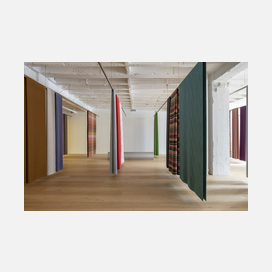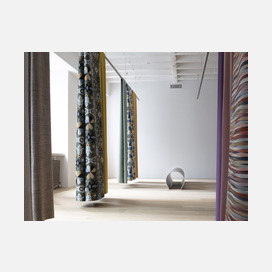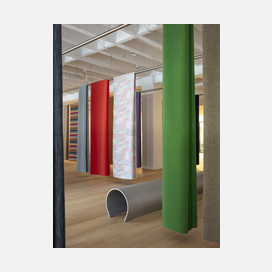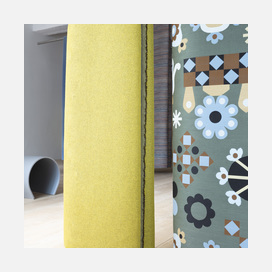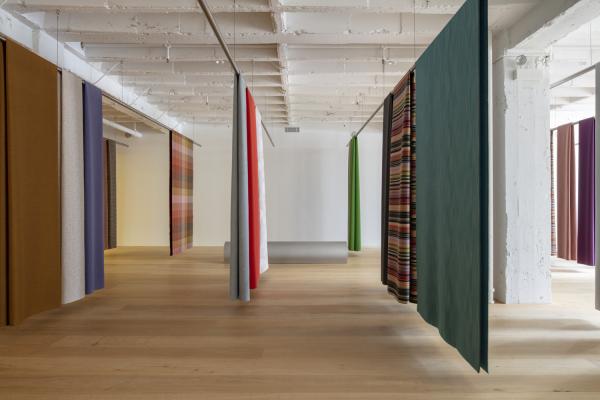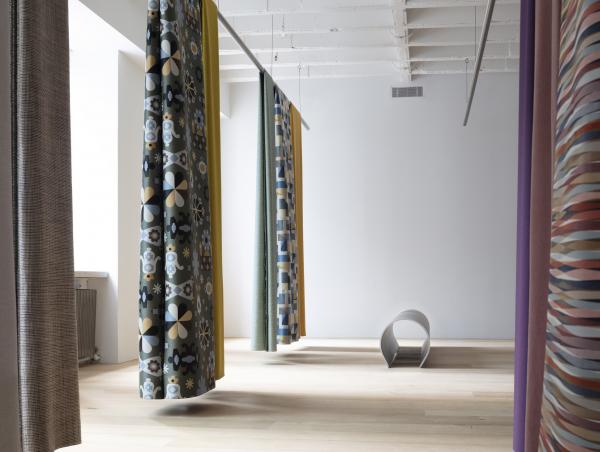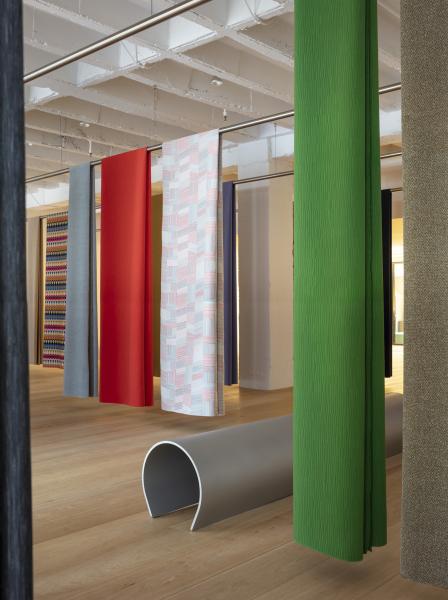For NeoCon 2019, Maharam presents a new installation in collaboration with the American designer, Leon Ransmeier. This marks the fourth consecutive year of creative cooperation between Ransmeier and the Maharam Design Studio.
Each year, Maharam transforms its Chicago showroom into an open gallery space in which a minimum of product can be shown to its best advantage. Moving away from a central structure, this year’s installation delivers atmospheric impact of unprecedented scale while acting as an extension of the existing architecture.
The installation builds upon the suspended tubular system that was initially designed for NeoCon 2018. The Maharam Design Studio and Ransmeier Inc. jointly arrived at a concept that would significantly amplify its previous iteration. This year’s expanded variant joins tubular modules into continuous thirty-five-foot lengths while significantly increasing the quantity of tubes employed. The resulting structure features seven parallel, stainless-steel bars suspended nine feet overhead in even increments along the length of the showroom, offering dramatically increased flexibility for display. Building upon its own vocabulary, the structure’s evolution can thus be traced from an x-formation to this year’s populous field suggesting infinite lines floating in space.
Rather than imposing an architecturally incongruous structure, the studios opted to work with the showroom’s existing roof and exposed ceiling from the Merchandise Mart’s opening in 1930—a feature unique to showroom 1188. Ransmeier Inc. engineered a cable system that avoids boring through to the undersides of the bars, offering a seamless impression when viewed from below. The showroom’s coffered ceiling required additional built-in flexibility as its network of joists and beams limits drilling locations and cable positions. A solution of multiple overhead, keyhole-like slots enabled an installation that is ultimately compact, readily disassembled, and easily reconfigured.
A restrained material vocabulary of metal elements, white walls, and white oak floors provides a pristine platform for the eighteen-foot-long textile panels. Due to this structure’s significantly expanded flexibility for display, the placement of each textile is determined onsite based on its textural, volumetric, or chromatic qualities. As told by a senior member of the Maharam Design Studio: “We find the best outcome emerges when we embrace the fluidity of the system and determine an intuitive arrangement in real time.” Visitors’ pathways are similarly left open to offer multiple points of entry to a meandering, personalized journey through the installation. Bold patterns by Sonnhild Kestler, Hella Jongerius, and Paul Smith join small-scale textures by Kvadrat collaborators Finn Sködt, Margrethe Odgaard, and Georgina Wright—united by complementary work of the Maharam Design Studio throughout.
Two rolled benches adapt the inclined metal plinths of last year’s installation with inverted arcs formed by single sheets of half-inch-thick aluminum. Due to the material’s heft, each bench required the use of heavy industrial equipment uncommonly used for refined interior furnishings to achieve its direct curvature. Offering an anchor to the textiles’ suspension within the installation, the benches echo their fluid, uninterrupted expanses.
About Leon Ransmeier
Leon Ransmeier is an American designer. A graduate of the Rhode Island School of Design, he founded his New York-based studio, Ransmeier Inc., in 2010. He has since designed furniture and interior products for clients including Arita 2016/, HAY, Herman Miller, and Mattiazzi. This is his fourth NeoCon installation for Maharam. A forthcoming backpack will join Maharam’s continuing series of utilitarian bags this fall, which includes designs by Konstantin Grcic and Jasper Morrison, among others.
